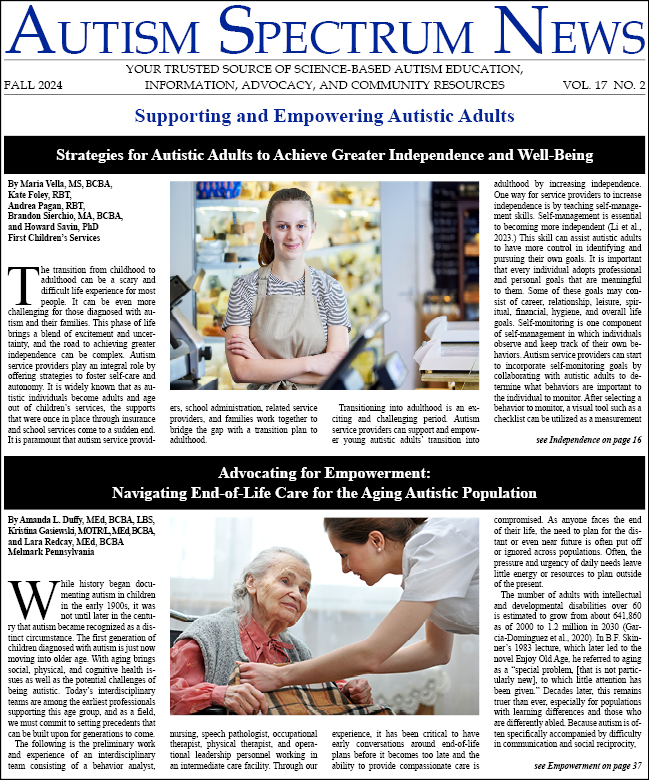Co-existing psychiatric disorders in individuals on the autism spectrum are common. Based on clinical and community studies, there is strong evidence that up to 70 percent of people with autism meet diagnostic criteria for at least one emotional or behavioral disorder.
The presence of these co-existing disorders have a dramatic impact on the lives of individuals with autism, as well as their families and caregivers. Clinicians and families need to be vigilant and watch for emotional and behavioral changes. If these disorders exist, a referral for a comprehensive psychiatric evaluation is necessary. These evaluations should be performed by professionals with specific expertise in the assessment and diagnosis of autism spectrum disorders with co-occurring psychiatric disorders.
It is important to understand these co-morbidities. How do they present? At what ages? What treatments are effective?
Professionals need to provide treatment and intervention directed at the specific symptoms and behaviors. Effective treatments are available which include intensive behavioral, cognitive-behavioral and other psychotherapeutic approaches. Pharmacological strategies can be very effective in achieving significant control of symptoms and behaviors.
“Emotional dysregulation” is a commonly used term when discussing emotional and behavioral issues in those diagnosed with an autism spectrum disorders (ASD). The symptoms and behaviors may include irritability, temper tantrums, hyperactivity and self-injurious behaviors.
We need to separate these symptoms and behaviors and understand whether they reflect underlying mood, anxiety, impulse control and psychotic disorders.
It is critical to differentiate emotional dysregulation from other emotional/behavioral presentations of autism that are often described as new onset disorders. This differentiation may be difficult to determine because many new onset co-morbid psychiatric disorders we see in our clinical practice overlap significantly with early onset emotional dysregulation as well as behaviors that are part of the autism spectrum. Some clinicians prefer to avoid making a psychiatric diagnosis because of this overlap. However, to understand patterns of symptoms and behavioral presentations, and develop specific effective treatments targeting these clinical issues, clinicians should be rigorous in their efforts to accurately diagnose and disentangle the mental health issues that pose so many challenges for seven out of 10 people with ASD.
Common co-morbid diagnoses in children, adolescents and adults with ASD are anxiety disorders, especially obsessive-compulsive disorder and social anxiety; attention deficit hyperactivity disorder; mood disorders, particularly depression and bipolar disorders; tic disorders, like Tourette’s syndrome; sleep disorders and elimination disorders like soiling and bed-wetting.
The following vignettes of clinical situations provide an opportunity to understand how particular disorders may present themselves:
Attention Deficit Hyperactivity Disorder (ADHD affects 20-35 percent of individuals with ASD): Brian is a 4-year-old with a history of significant language delay. He started using single words at age 3 and a year later began repeating what others said to him. He is extremely active and unable to sit still. When in an enclosed space, he pushes furniture over, throws things and runs from one corner of the room to the other, even attempting to dart out of the room. He gets easily frustrated and has frequent tantrums when limits are set by his parents. In addition to his ADHD, he appears to be oppositional and defiant. However, this may reflect his frustration with his inability to communicate and delay in the development of receptive and expressive skills.
Obsessive Compulsive Disorder (affects 10-25 percent of people with ASD): Maria is a 13-year-old whose abrupt change in behavior led her to insist that her family’s home be arranged a certain way. The chairs need to be in the exact same position next to the dining table; all the TVs in the house have to be on at the same time and all the doors closed. She has the intense need to watch the exact same TV show from beginning to end repeatedly and if this routine is disrupted she gets extremely upset. These ritualistic behaviors were not present six months earlier. Within that time period, Maria and her family moved to a new neighborhood and she was placed in a new school. It seems that these changes were stressors that triggered the onset of these behaviors.
Social Anxiety (affects 10-20 percent of people with ASD): Elijah is a socially isolated 16-year-old who has a diagnosis of Asperger’s syndrome. Over the past three months, he has found it progressively harder to be with unfamiliar people without getting markedly anxious. He now avoids all social situations, even gatherings of family and close friends. Making eye contact upsets him, so he finds some relief looking down or past people.
Mood Disorder (affects 5-15 percent of individuals with ASD): At the age of 15, Nigel presented with a sudden onset of irritability, which last more than a month. He also began having difficulty falling asleep and staying asleep through the night. His irritability alternated with periods of giddy happiness along with brief intense periods of sadness with no apparent reason for the sudden shift. Nigel’s symptoms are consistent with a mood disorder, possibly of a bipolar type.
Tic Disorders (affects 5-10 percent of individuals with ASD): Jenny is a 9-year-old with a two-year history of an increasing frequency of throat clearing sounds, and a six-month history of jerking movements involving her head and neck. These movements have fluctuated in intensity and frequency. More recently, they have been accompanied by obsessive compulsive behaviors.
Cognitive-behavioral and intensive structured behavioral interventions and the careful use of psychotropic medication have the potential to significantly reduce the severity of these issues and improve the quality of life of the individual with ASD, as well as his or her family or caregiver.
Charles N. Cartwright, MD, is Director of the YAI Autism Center and Chief of the Premier HealthCare Autism Research and Treatment Institute. Victoria Bein, MA, MS, is Coordinator at the Premier HealthCare Autism Research and Treatment Institute. Premier HealthCare is a member of the YAI Network.




